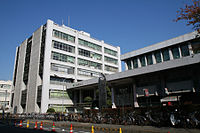Ōmiya-ku, Saitama
|
Ōmiya-ku, Saitama 大宮区 |
|
|---|---|
| Ward | |
| Ōmiya Ward | |

Ōmiya Ward Office
|
|
 Location of Ōmiya-ku in Saitama |
|
| Coordinates: 35°54′23.2″N 139°37′43.1″E / 35.906444°N 139.628639°ECoordinates: 35°54′23.2″N 139°37′43.1″E / 35.906444°N 139.628639°E | |
| Country | Japan |
| Region | Kanto |
| Prefecture | Saitama |
| City | Saitama |
| Area | |
| • Total | 12.80 km2 (4.94 sq mi) |
| Population (February 2016) | |
| • Total | 113,742 |
| • Density | 8,890/km2 (23,000/sq mi) |
| Time zone | Japan Standard Time (UTC+9) |
| -Flower | Sakura |
| Phone number | 048-835-3156 |
| Address |
3-1 Daimon, Ōmiya-ku, Saitama-shi, Saitama-ken 330-8501 |
| Website | www |
3-1 Daimon, Ōmiya-ku, Saitama-shi, Saitama-ken
Ōmiya (大宮区 Ōmiya-ku?) is one of ten wards of the city of Saitama, in Saitama Prefecture, Japan, and is located in the northeastern part of the city. As of 1 February 2016[update], the ward had an estimated population of 113,742 and a population density of 8,890 persons per km². Its total area was 12.80 square kilometres (4.94 sq mi). Although Urawa-ku is the governmental center of Saitama City, Ōmiya-ku is the most active commercial and business centre in both Saitama City and Saitama Prefecture thanks to its transport infrastructure, especially railways connected at Ōmiya Station.
Ōmiya Ward is within the Ōmiya Terrace of the Kantō plain, in the center of Saitama City. It is in the Greater Tokyo Area and about 25 km north of central Tokyo.
Ōmiya-ku is surrounded by Nishi-ku (to the west), Kita-ku (north), Minuma-ku (east), Urawa-ku (southeast), Chūō-ku (south), and Sakura-ku (southwest).
Ōmiya derives its name from a famous Shinto shrine, the Hikawa Shrine, which has been a place of pilgrimage since at least the Heian period. During the Edo period, the area flourished as Ōmiya-shuku, a post station on the Nakasendō highway, which connected Edo with Kyoto. Following the Meiji restoration, it became part of Urawa Prefecture which merged with Iwatsuki, Urawa, and Oshi Prefectures n 1871 to form Saitama Prefecture. The modern town of Ōmiya was officially created within Kitaadachi District, Saitama with the establishment of the municipalities system on April 1, 1889.
...
Wikipedia

